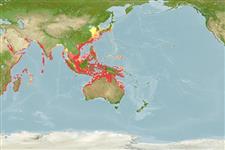| Native range | All suitable habitat | Point map | Year 2100 |

|
| Parastromateus niger AquaMaps Data sources: GBIF OBIS |
Length at first maturity
Lm ?, range 22 - 24 cm
Human uses
Fisheries: highly commercial
Phylogenetic diversity index
(Ref. 82805)
PD50 = 1.0000 many relatives (e.g. carps) 0.5 - 2.0 few relatives (e.g. lungfishes)
Trophic Level
(Ref. 69278)
2.9 ±0.35 se; Based on food items.
Resilience
(Ref. 69278)
High, minimum population doubling time less than 15 months (K=0.6)